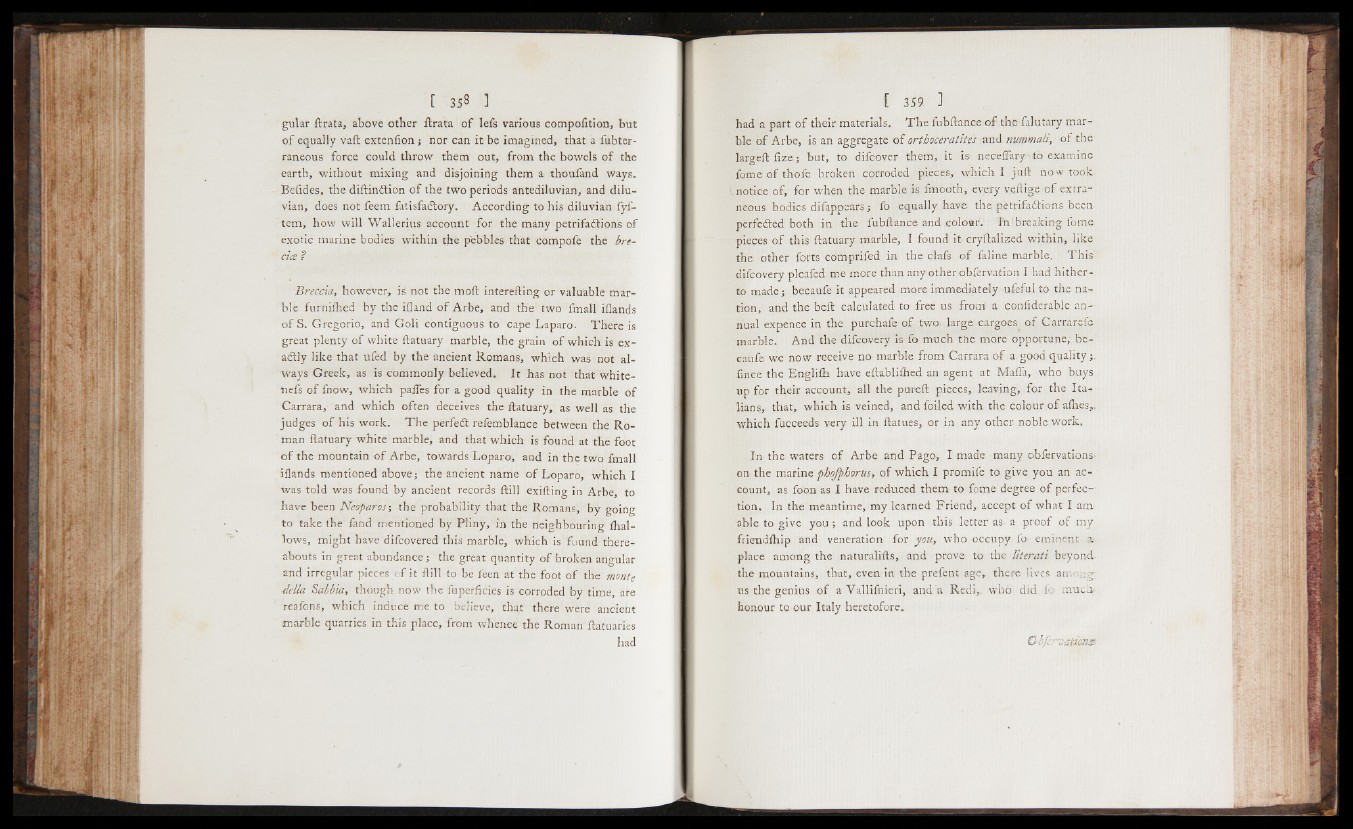
gular ftrata, above other ft rata o f lefs various compofition, but
o f equally vail extenfion ; nor can it be imagined, that a fubter-
raneous force could throw them out, from the bowels o f the
earth, without mixing and disjoining them a thoufand ways.
Belides, the diftinition of the two periods antediluvian, and dilu-
vian, does not feem fatisfadlory. According to his diluvian fyf-
tem, how will Wallerius account for the many petrifactions of
exotic marine bodies within the pebbles that compofe the bre-
cice ?
Breccia, however, is not the moil interefting or valuable marble
furniihed by the iiland o f Arbe, and the two fmall iflands
o f S. Gregorio, and Goli contiguous to cape Laparo. There is
great plenty o f white ftatuary marble, the grain o f which is exactly
like that ufed by the ancient Romans, which was not always
Greek, as is commonly believed. It has not that white-
nefs o f fnow, which paifes for a good quality in the marble of
Carrara, and which often deceives the ftatuary, as well as the
judges o f his work. The perfedt refemblance between the Roman
ftatuary white marble, and that which is found at the foot
o f the mountain o f Arbe, towards Loparo, and in the two fmall
iflands mentioned above; the ancient name o f Loparo, which I
was told was found by ancient records ftill exifting in Arbe, to
have been Neoparos-, the probability that the Romans, by going
to take the fand mentioned by Pliny, in the neighbouring fhal-
lows, might have difcovered this marble, which is found thereabouts
in great abundance; the great quantity of broken angular
and irregular pieces of it ftill to be feen at the foot o f the monte
M ia Sabbia, though now the fuperficies is corroded by time, are
reafons, which induce me to believe, that there were ancient
marble quarries in this place, from whenee the Roman ftatuaries
had
had a part of their materials. The fubflance o f the falutary marble
o f Arbe, is an aggregate o f orthoceratites and nummali, o f the
largeft liz e ; but, to difcover them, it is neceffary to examine
fome o f thofe broken corroded pieces, which I juft now took.
\ notice of, for when the marble is fmooth, every veftige o f extraneous
bodies difappears; fo equally have the petrifa&ions been
perfedted both in the fubftance and .colour. In'breaking fome
pieces of this ftatuary marble, I found it cryftalized within, like
the other forts comprifed in the clafs o f faline marble. This
difcovery pleafed. me more than any other obfervation I had hitherto
made; becaufe it appeared more immediately ufeful to the nation,
and the bell calculated to free us from' a coniiderable annual
expence in the purchafeof two- large cargoes^ o f Carrarefe:
marble. And the difcovery is fo much the more opportune, becaufe
we now receive no marble from Carrara o f a. good quality;.
lince the Englilh have eftabliihed an agent at Malfa, who buys
up for their account, all the pureft pieces, leaving, for the Italians,
that, which is veined, and foiled with the colour o f allies,,
which fucceeds very ill in ftatues, or in any other noble work.
In the waters o f Arbe and Pago, I made many obfervations-
on the marine phofphorus, of which I promife to give you an account,
as foon as I have reduced them to fome degree o f perfection.
In the meantime, my learned Friend,, accept of what I am
able to give you ; and look upon this letter as a proof o f my
friendihip and veneration for you, who occupy fo eminent
place among the naturalifts, and prove to the literati beyond-
the mountains, that, even in the prefent age, there lives among;
us the genius o f a Vallifnieri, and a Redi,, who did fo mucn
honour to our Italy heretofore.
&bJer~jationss